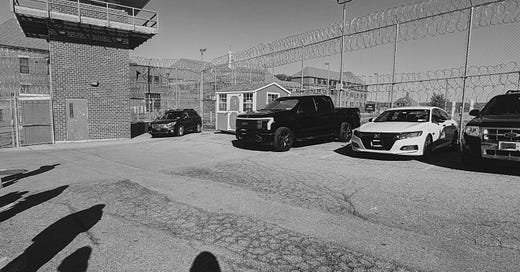The complexities of body image in prison: reflections from incarcerated men in New York State
"Being the 'skinny kid' won’t work in prison."
Prisons represent the most severe form of control over people’s bodies.
It’s not just the electric fences and barbed wire that restrict people, it’s also the web of endless prison rules and inhumane conditions that create complex layers of confinement. So while some people may stereotype incarcerated people as “tattooed, jacked-up meathead[s] with bad attitude[s] and little regard for the law,” (as comically put by Liu at Woodbourne Correctional Facility) the story is (obviously!) much more complicated than that.
Everything from what time you’re allowed to walk from one building to another, to how fast you’re allowed to move without causing suspicion, has to be navigated. Moments of true privacy are never guaranteed, and any sense of bodily autonomy is easily erased by invasive strip searches. Incarcerated people often seek temporary escapes within their minds: by talking to loved ones on the phone, reading books, listening to music, making art, and more.
But while the mind may occasionally wander outside the prison walls, the body remains stuck inside them.
The body ages while the person’s sentence winds down, or winds on with little hope of future release. The body has to stand for “the count” five times a day. The body is on alert and has to be ready for anything to happen. The body is exposed with very little means of protection other than its own muscles.
People with little exposure to prison have often heard about the extreme exercise regimes that some incarcerated people maintain. It’s a cliche that fails to represent the large variety of people in prison, but in many ways, it does seem like a logical response to a prison environment. By confining people and giving them no escape from each other, we’ve created conditions where physical strength is an important form of protection; when “flight” is not a guaranteed option, the best bet is to be ready to “fight”, even when it’s the last thing you want to do.
It’s within these unique circumstances that a culture of praising strength and dominance can grow, and any signs of physical weakness (as illegitimate as they might be) are denigrated.
For example, I’ve heard how people teased Jonathan any time he gained even the slightest amount of body fat (literally grabbing his belly and saying “What happened?!”), and praise him any time he gained muscle mass (“You have size on you, it looks good” and “Make sure you keep that up when you go home”).
So how do people in prison view their bodies?
Jonathan and I surveyed a handful of incarcerated men in Fishkill and Woodbourne Correctional Facilities in New York to get their reflections, which are summarized below. Their stories give us a glimpse into how body image in prison is intertwined with issues of survival, power, personal histories, acceptance, and more.
When I first came to prison at age 20, I saw my thinness as a sign of weakness, so I wanted to get bigger. Being “the skinny kid” won’t work in prison. People work out to protect themselves. Back then I didn’t work out for health reasons, but now I do. It makes me feel better about myself. - Garcia, Fishkill Correctional Facility
We have more time to focus on our bodies in prison, but being involved in a gang can make that more difficult. In my case, I was getting in fights and being put into solitary confinement frequently, where lack of adequate food is an issue. It makes it hard to maintain body mass. - Y.O., Fishkill Correctional Facility
Most people would describe the average incarcerated person as a tattooed, jacked-up meathead with a bad attitude and little regard for the law. And most people would be surprised at how wrong they are. The majority of incarcerated people are just one honeybun away from a heart attack. The minority are those who are conscious that their body is constantly being judged by others as a potential threat. In an environment that accentuates the survival of the fittest, bulging biceps and washboard abs are an indication of strength and physical prowess. As such, when honed to the likeness of a Navy SEAL or a New Orleans linebacker, one’s body may provide a sense of pride and safety. Unfortunately, the pursuit of physical excellence may take years, filled with competition and insecurity. - Liu, Woodbourne Correctional Facility
The prison environment plays a big role in our body image. Your ability to stay healthy depends on the facility you’re in because the access to food is so varied. I came to prison skinny for my first bid and then went home that way. I came back to prison and didn’t want to go home skinny again, so I started working out hard. - Rhino, Fishkill Correctional Facility
I was fat when I came to prison, and prison has allowed me to take better care of myself. I got involved in bodybuilding and worked out until I got down to 8% body fat. - Wavy, Fishkill Correctional Facility
I grew up in a foster home because I was abused in my family home. I found that in prison I started working out so much that I became just skin and bone and muscle, and it fueled anger in me. It made me feel powerful over others, which turned out not to be a good thing. My experience of taking a beating in childhood made me feel like I could give it out to others. Now that I am older I’ve slowed down and realized I need to think better. - George, Fishkill Correctional Facility
I can’t say prison has impacted my body image. I work out to pass the time and don’t really care about my appearance. - Ron, Fishkill Correctional Facility
I always felt that in order to be accepted by others, I had to look good. If I was fat, people would crack jokes about me all the time, and I’d be considered weak. In order to fit in and build your reputation, it’s best to be in the yard being seen working out. Some people like to train others, but sometimes they can be extremely rough with you when they train you. They put you in a position to get hurt. It’s sadistic. They take pride in breaking you, it contributes to their image. - Jonathan, Fishkill Correctional Facility
My ideal body image changed with the group I was around. When I first came to prison, I used working out as a stress reliever. I was around other like-minded individuals. We used to work out from sun up to sun down competing with one another to see who can get big and more ripped up. That led to lifting way too much weight and doing way too many reps, which ultimately resulted in injury. Eventually, I stopped working out with those guys and joined a different group. This group focused on working out just to keep your body and mind fit for fighting. For a while that was my world: I trained every day to make myself ready and as fit as possible for whatever situation. We used to run miles, spar, and do kinesthetics (no weights). I was in the best shape of my life then, but mentally I was in ready-to-fight mode and I knew that I needed to change that. I didn't want to have that mind frame. I ended up finding my own path in yoga. A friend of mine introduced me to it and I loved it. With yoga, you stay trim, fit, limber, and in shape. My mind began to change from ready-to-fight mode to love-life mode. I stopped caring if I was big and cut up. My mind was focused on more important things like being healthy and eating the right foods (I became a vegetarian). Going down this path helped me become my own person regardless of what other people think. What I think of myself is more important. - Amun, Woodbourne Correctional Facility
We’ll be continuing to correspond with incarcerated individuals on this topic and others, so feel free to leave your questions or comments for them below and we will pass them along.







This has been really illuminating for someone who has struggled with inherited body image disorders for much of my life. It was clear what came from the women in my family, but this put my father’s fierce hatred of his own body into better perspective (in light of his experiences of incarceration). I had felt the trauma, but couldn’t locate it. This feels very healing, thank you
This is such important work. Thank you Brittany and Jonathan for collecting and sharing these stories!